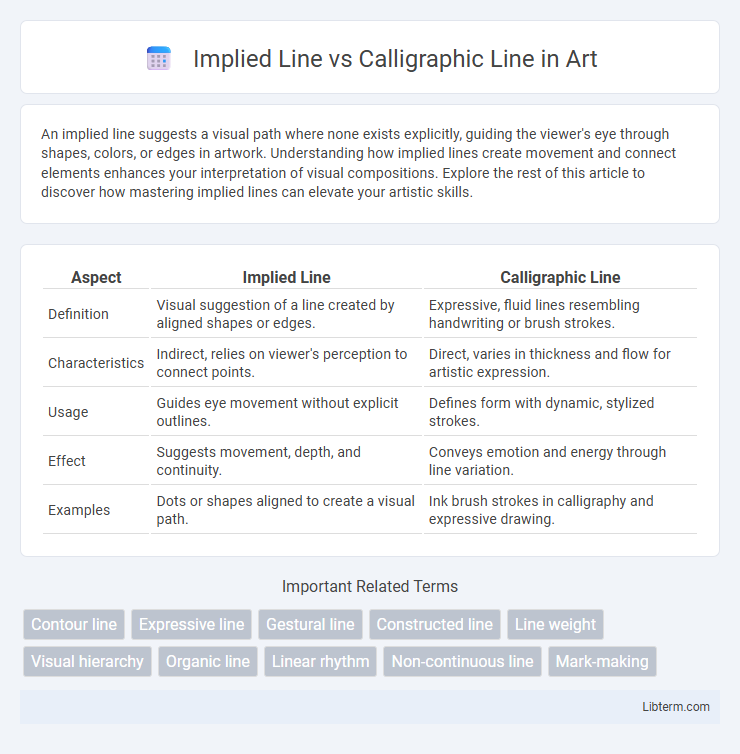An implied line suggests a visual path where none exists explicitly, guiding the viewer's eye through shapes, colors, or edges in artwork. Understanding how implied lines create movement and connect elements enhances your interpretation of visual compositions. Explore the rest of this article to discover how mastering implied lines can elevate your artistic skills.
Table of Comparison
| Aspect | Implied Line | Calligraphic Line |
|---|---|---|
| Definition | Visual suggestion of a line created by aligned shapes or edges. | Expressive, fluid lines resembling handwriting or brush strokes. |
| Characteristics | Indirect, relies on viewer's perception to connect points. | Direct, varies in thickness and flow for artistic expression. |
| Usage | Guides eye movement without explicit outlines. | Defines form with dynamic, stylized strokes. |
| Effect | Suggests movement, depth, and continuity. | Conveys emotion and energy through line variation. |
| Examples | Dots or shapes aligned to create a visual path. | Ink brush strokes in calligraphy and expressive drawing. |
Introduction to Line in Art
Implied lines in art create visual connections by guiding the viewer's eye through a composition without being physically drawn, often formed through shapes, colors, or the direction of figures. Calligraphic lines, in contrast, are expressive, fluid strokes inspired by handwriting, emphasizing movement and emotion through varying thickness and curvature. Understanding these distinct line types enhances the ability to convey depth, rhythm, and focus within artistic works.
Defining Implied Line
An implied line is a visual path created by the arrangement of elements that guide the viewer's eye without a continuous mark, often formed through the alignment of shapes, colors, or implied edges. Unlike calligraphic lines, which are defined by expressive, hand-drawn strokes with varying thickness and fluidity, implied lines rely on suggestion and viewer perception to establish direction or connection. This foundational concept in design and art emphasizes the importance of spatial relationships and visual flow over explicit linework.
Understanding Calligraphic Line
Calligraphic line emphasizes fluidity and expressive movement, characterized by varying thickness and rhythm that mimic hand-drawn strokes, enhancing visual texture and emotional impact. In contrast, implied line relies on the viewer's perception to connect disjointed elements, creating a suggested path rather than a continuous mark. Understanding calligraphic line involves recognizing its role in conveying dynamism and personality through deliberate modulation of line weight and curvature.
Visual Differences Between Implied and Calligraphic Lines
Implied lines create visual pathways through a series of points or shapes, guiding the viewer's eye without a continuous mark, often relying on negative space and viewer perception for completion. Calligraphic lines are characterized by their fluid, expressive quality, varying in thickness and curvature, reflecting the motion and pressure of the artist's hand. The key visual difference lies in implied lines' suggestion of form versus the tangible, dynamic presence of calligraphic brushstrokes or pen marks.
Techniques for Creating Implied Lines
Techniques for creating implied lines include the strategic placement of shapes, colors, or edges that guide the viewer's eye without a continuous physical line. Artists often use a series of dots, contrasting colors, or alignment of objects to form an invisible path that the mind perceives as a line. Calligraphic lines differ by using expressive, flowing strokes that vary in thickness and pressure to create a visible, dynamic contour.
Techniques for Drawing Calligraphic Lines
Techniques for drawing calligraphic lines emphasize control of pressure and speed to create varied line thickness and dynamic flow, often utilizing flexible nib pens or brushes to enhance expressiveness. Mastery of wrist and arm movement allows smooth transitions and fluidity, distinguishing calligraphic lines from implied lines, which rely on visual suggestion rather than physical marks. Calligraphic lines demand deliberate strokes that vary in opacity and weight, producing a rhythmic and elegant aesthetic in drawing and lettering.
Expressive Qualities of Implied Lines
Implied lines create a sense of movement and direction by suggesting boundaries without explicitly drawing them, often guiding the viewer's eye through negative space or recurring elements. These lines evoke emotional responses by fostering rhythm and tension, enriching the expressiveness of an artwork. Unlike calligraphic lines, which emphasize fluid, gestural strokes, implied lines rely on visual cues and viewer perception to convey form and dynamism.
Expressive Qualities of Calligraphic Lines
Calligraphic lines exhibit dynamic variation in width and fluidity, creating expressive qualities that convey rhythm, emotion, and movement within artwork. Unlike implied lines, which rely on visual cues to guide the viewer's eye, calligraphic lines physically manifest brushstrokes or penmanship that emphasize gestural, organic forms. This tactile and spontaneous nature enhances the emotional impact and artistic individuality in traditional and digital calligraphy.
Artistic Applications and Examples
Implied lines guide the viewer's eye through a composition using visual cues like shapes or edges, often seen in works like da Vinci's "The Last Supper," where gaze direction and object placement create flow without actual lines. Calligraphic lines emphasize expressive, fluid strokes that vary in thickness, commonly used in East Asian brush painting and modern abstract art to convey emotion and movement. Both techniques enhance artistic narratives by manipulating line qualities to evoke depth, rhythm, and focus within the artwork.
Choosing Between Implied and Calligraphic Lines
Choosing between implied and calligraphic lines depends on the desired visual impact and narrative clarity. Implied lines guide the viewer's eye subtly through composition by creating a sense of direction without continuous strokes, enhancing fluidity and movement in design. Calligraphic lines emphasize expressive quality and texture, making them ideal for artworks that require dynamic energy and ornamental detail.
Implied Line Infographic

 libterm.com
libterm.com